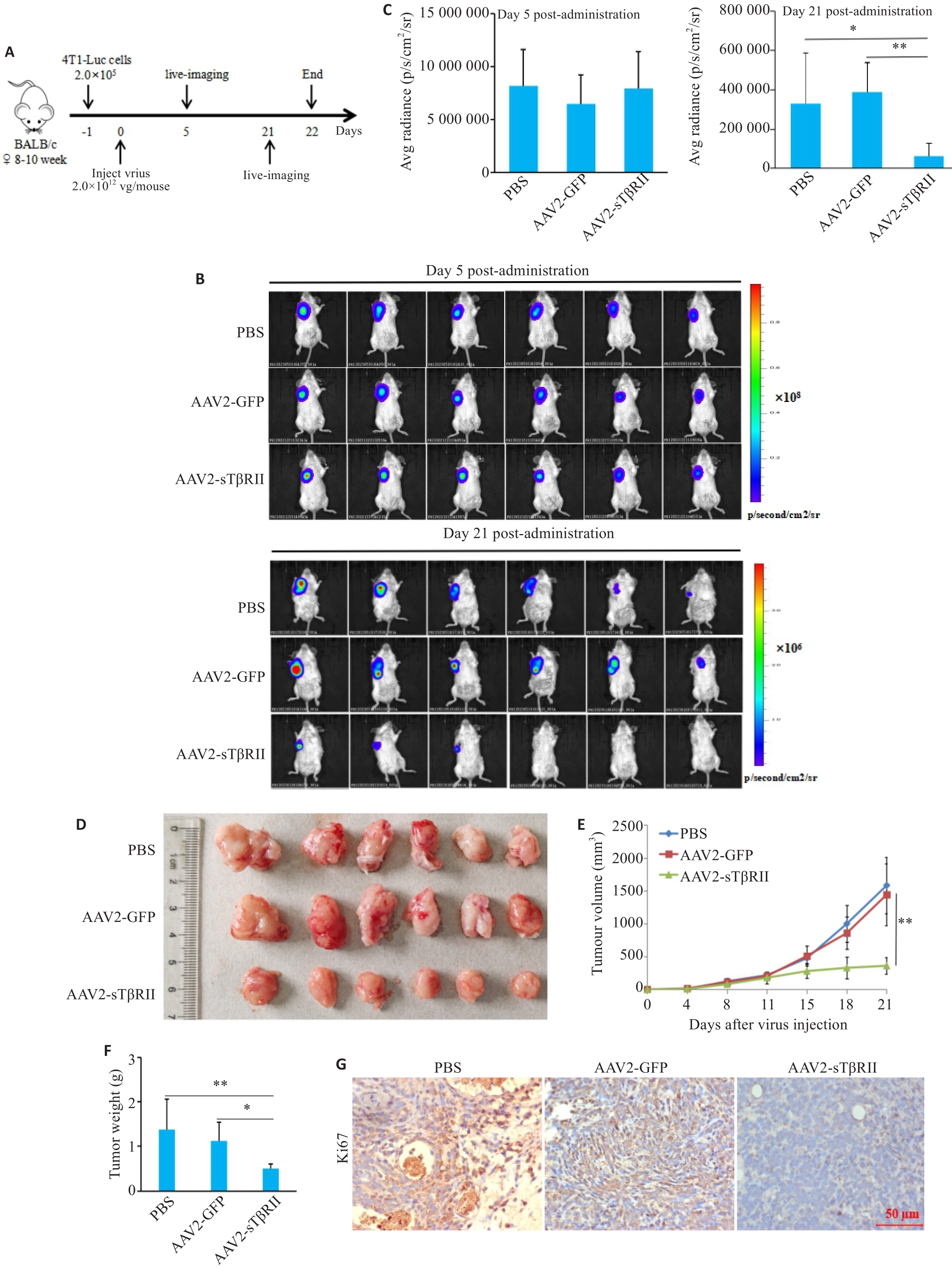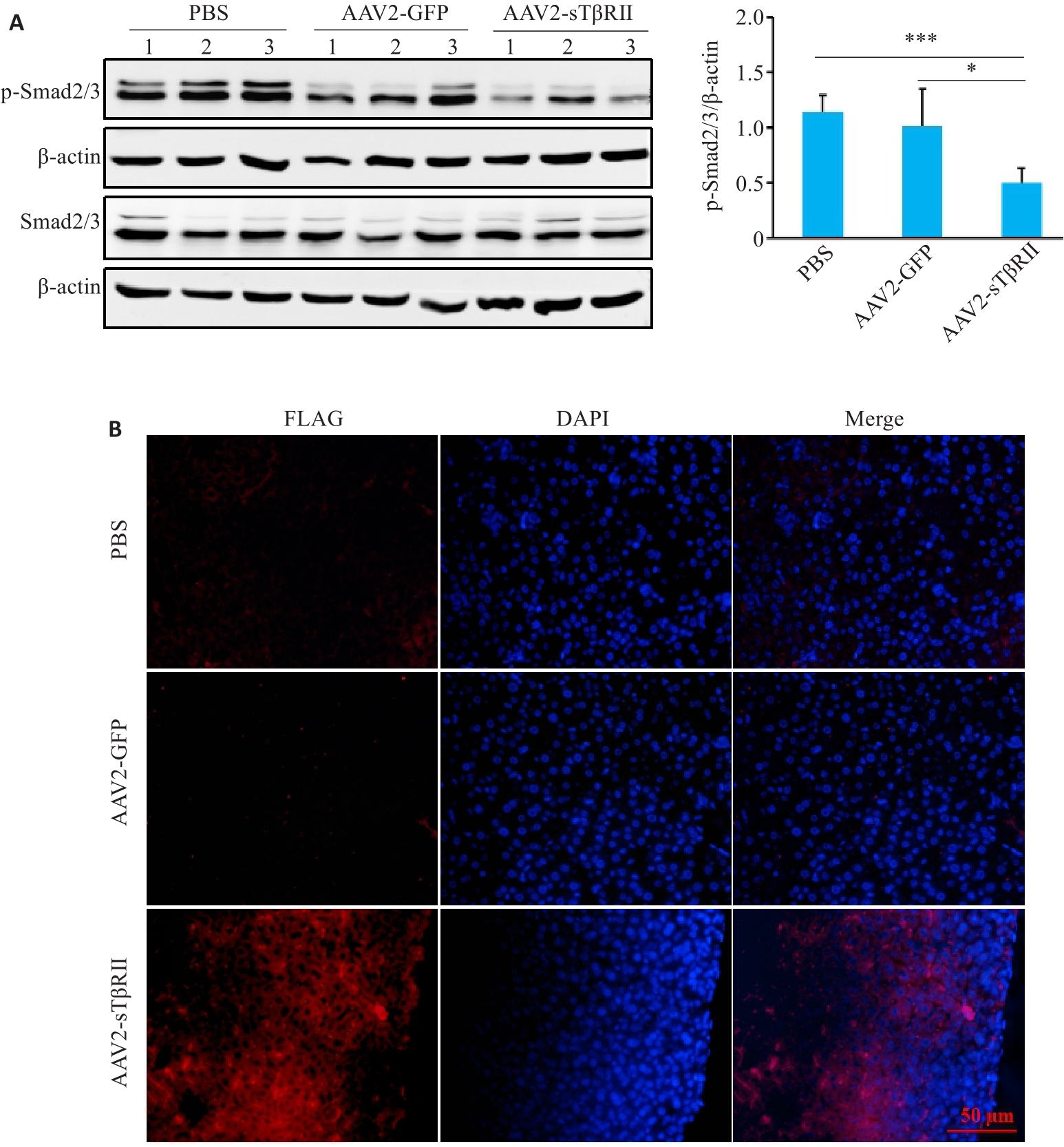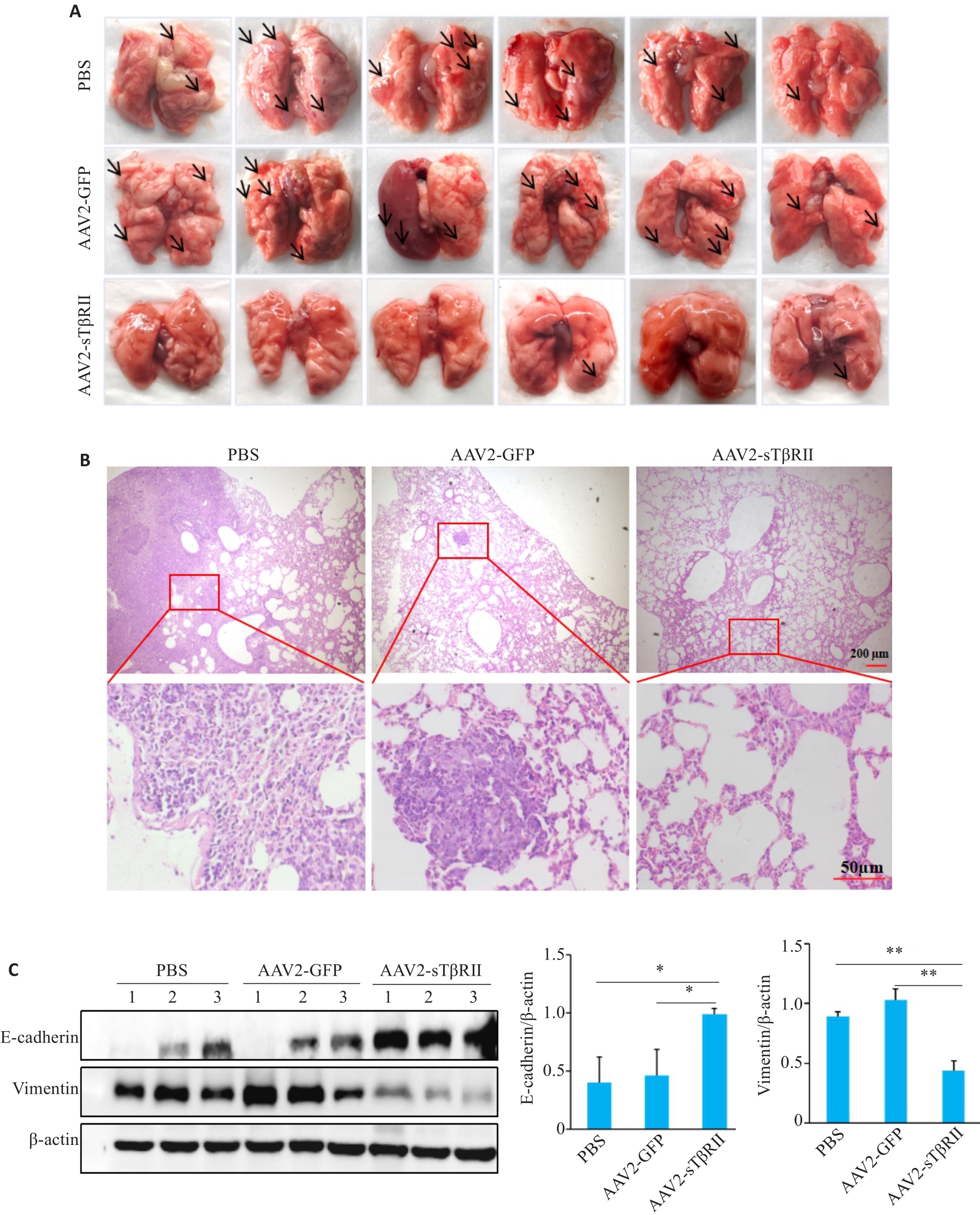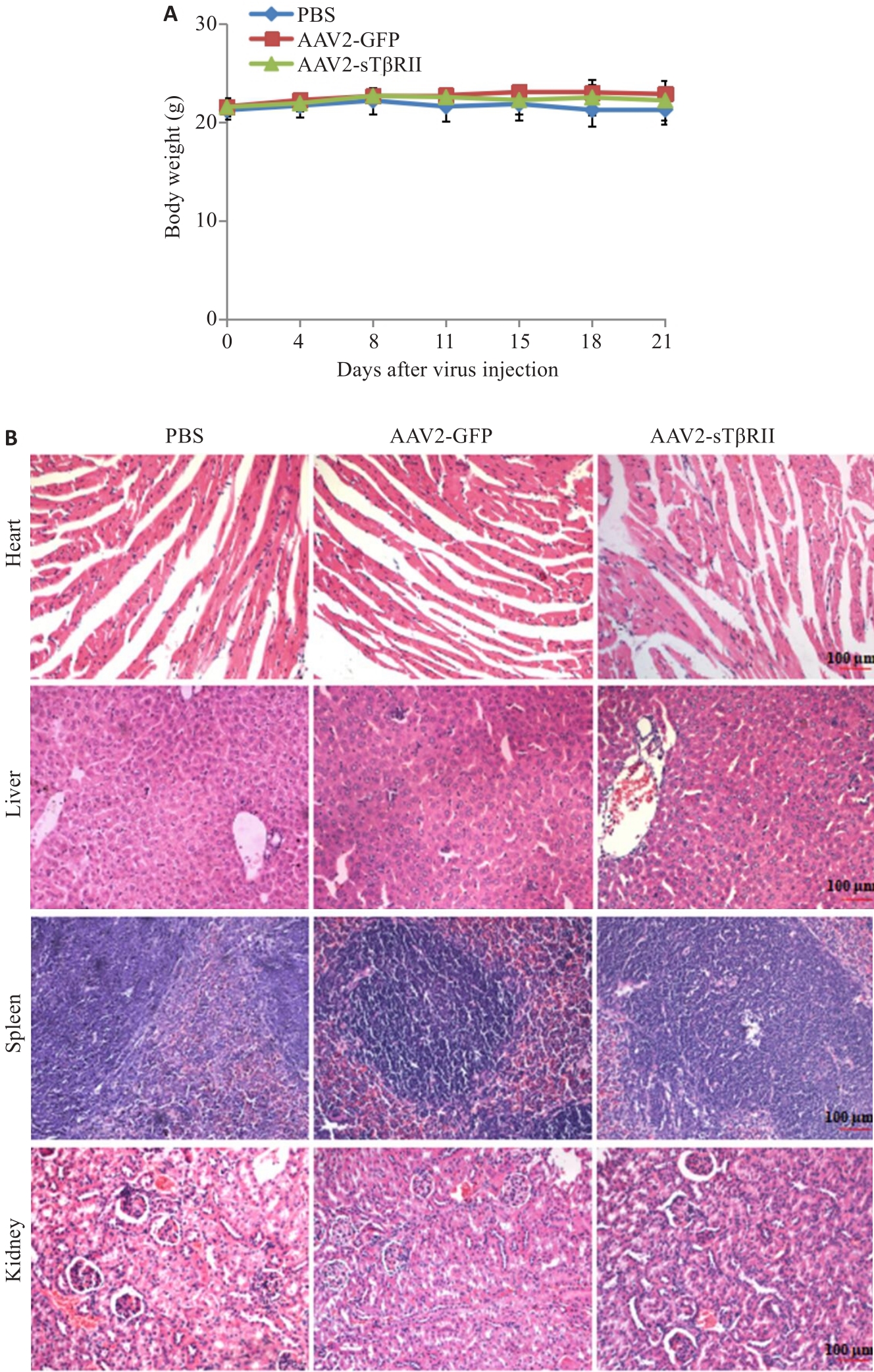Journal of Southern Medical University ›› 2024, Vol. 44 ›› Issue (5): 818-826.doi: 10.12122/j.issn.1673-4254.2024.05.03
• Basic Research • Previous Articles Next Articles
Zhi CUI1,2( ), Cuijiao MA1,2, Qianru WANG1,2, Jinhao CHEN1,2, Ziyang YAN2, Jianlin YANG1,2, Yafeng LÜ1,2, Chunyu CAO1,2(
), Cuijiao MA1,2, Qianru WANG1,2, Jinhao CHEN1,2, Ziyang YAN2, Jianlin YANG1,2, Yafeng LÜ1,2, Chunyu CAO1,2( )
)
Received:2023-10-26
Online:2024-05-20
Published:2024-06-04
Contact:
Chunyu CAO
E-mail:2321939351@qq.com;caocy@ctgu.edu.cn
Supported by:Zhi CUI, Cuijiao MA, Qianru WANG, Jinhao CHEN, Ziyang YAN, Jianlin YANG, Yafeng LÜ, Chunyu CAO. A recombinant adeno-associated virus expressing secretory TGF‑β type II receptor inhibits triple-negative murine breast cancer 4T1 cell proliferation and lung metastasis in mice[J]. Journal of Southern Medical University, 2024, 44(5): 818-826.
Add to citation manager EndNote|Ris|BibTeX
URL: https://www.j-smu.com/EN/10.12122/j.issn.1673-4254.2024.05.03

Fig.2 AAV2-sTβRII inhibits proliferation of transplanted 4T1 xenograft tumors in mice. A: Gene therapy model in mice. B: Representative images of bioluminescence in mice on days 5 and 21 after Intravenous Injections. C: Statistical diagram of tumors fluorescence signal value. D: Images of tumors from the experiment group (AAV2-sTβRII) and the control groups (PBS and AAV2-GFP). E: Growth curve of orthotopic transplantation tumors. F: Tumor weight of each group. G: Representative images of the immunohistochemical staining for Ki67 proteins in tumor sections. *P<0.05, **P<0.01.

Fig.3 AAV2-sTβRII inhibits Smad2/3 phosphorylation in transplanted 4T1 xenograft tumors in mice. A: Expression of p-Smad2/3 in tumor tissues. B: Immunofluorescence staining for sTβRII-Fc proteins in mice liver. *P<0.05, ***P<0.001.

Fig.4 Effects of AAV2-sTβRII virus on lung metastasis of 4T1 cell xenograft in mice. A: Representative images of the lungs from the mice in different groups (black arrows indicate visible metastatic nodules). B: HE staining of the lung sections. C: E-cadherin and vimentin protein expressions in 4T1 cell xenograft. *P<0.05, **P<0.01.

Fig.5 Toxic effects of intravenously injected AAV2-sTβR II virus in mice. A: Body weight changes of the mice. B: HE staining of the heart, liver, spleen and kidney of the mice.
| 1 | Zhang X, Ge X, Jiang T, et al. Research progress on immunotherapy in triple-negative breast cancer (Review)[J]. Int J Oncol, 2022, 61(2): 95. DOI: 10.3892/ijo.2022.5385 |
| 2 | Borri F, Granaglia A. Pathology of triple negative breast cancer[J]. Semin Cancer Biol, 2021, 72: 136-45. DOI: 10.1016/j.semcancer.2020.06.005 |
| 3 | Howard FM, Olopade OI. Epidemiology of triple-negative breast cancer: a review[J]. Cancer J, 2021, 27(1): 8-16. DOI: 10.1097/ppo.0000000000000500 |
| 4 | Fan Y, He S. The characteristics of tumor microenvironment in triple negative breast cancer[J]. Cancer Manag Res, 2022, 14: 1-17. DOI: 10.2147/cmar.s316700 |
| 5 | Emens LA, Loi S. Immunotherapy approaches for breast cancer patients in 2023[J]. Cold Spring Harb Perspect Med, 2023, 13(4): a041332. DOI: 10.1101/cshperspect.a041332 |
| 6 | Sharmni Vishnu K, Win TT, Aye SN, et al. Combined atezolizumab and nab-paclitaxel in the treatment of triple negative breast cancer: a meta-analysis on their efficacy and safety[J]. BMC Cancer, 2022, 22(1): 1139. DOI: 10.1186/s12885-022-10225-y |
| 7 | Peng D, Fu M, Wang M, et al. Targeting TGF-β signal transduction for fibrosis and cancer therapy[J]. Mol Cancer, 2022, 21(1): 104. DOI: 10.1186/s12943-022-01569-x |
| 8 | Zhao H, Wei J, Sun J. Roles of TGF-β signaling pathway in tumor microenvirionment and cancer therapy[J]. Int Immunopharmacol, 2020, 89(pt b): 107101. DOI: 10.1016/j.intimp.2020.107101 |
| 9 | Gao HC, Huang YZ, Liu YQ, et al. Role of TG2 and TGF-β1 in the pathogenesis of human breast cancer[J]. Oncol Lett, 2020, 20(5): 221. DOI: 10.3892/ol.2020.12057 |
| 10 | Lee JH, Massagué J. TGF-β in developmental and fibrogenic EMTs[J]. Semin Cancer Biol, 2022, 86(pt 2): 136-45. DOI: 10.1016/j.semcancer.2022.09.004 |
| 11 | Ren Y, Jia HH, Xu YQ, et al. Paracrine and epigenetic control of CAF-induced metastasis: the role of HOTAIR stimulated by TGF-ß1 secretion[J]. Mol Cancer, 2018, 17(1): 5. DOI: 10.1186/s12943-018-0758-4 |
| 12 | Batlle E, Massagué J. Transforming growth factor-β signaling in immunity and cancer[J]. Immunity, 2019, 50(4): 924-40. DOI: 10.1016/j.immuni.2019.03.024 |
| 13 | Trelford CB, Dagnino L, Di Guglielmo GM. Transforming growth factor-β in tumour development[J]. Front Mol Biosci, 2022, 9: 991612. DOI: 10.3389/fmolb.2022.991612 |
| 14 | Hao Y, Baker D, Ten Dijke P. TGF‑β‑mediated epithelial-mesenchymal transition and cancer metastasis[J]. Int J Mol Sci, 2019, 20(11): E2767. DOI: 10.3390/ijms20112767 |
| 15 | Zhou C, Wang D, Li J, et al. TGFB2-AS1 inhibits triple-negative breast cancer progression via interaction with SMARCA4 and regulating its targets TGFB2 and SOX2 [J]. Proc Natl Acad Sci USA, 2022, 119(39): e2117988119. DOI: 10.1073/pnas.2117988119 |
| 16 | Hussen BM, Hidayat HJ, Abdullah SR, et al. Role of long non-coding RNAs and TGF-β signaling in the regulation of breast cancer pathogenesis and therapeutic targets[J]. Cytokine, 2023, 170: 156351. DOI: 10.1016/j.cyto.2023.156351 |
| 17 | Wang Y. Recombinant Elabela-Fc fusion protein has extended plasma half-life and mitigates post-infarct heart dysfunction in rats[J]. Int J Cardiol, 2020, 300: 217-8. DOI: 10.1016/j.ijcard.2019.06.043 |
| 18 | Davidsohn N, Pezone M, Vernet A, et al. A single combination gene therapy treats multiple age-related diseases[J]. Proc Natl Acad Sci USA, 2019, 116(47): 23505-11. DOI: 10.1073/pnas.1910073116 |
| 19 | Gulley JL, Schlom J, Barcellos-Hoff MH, et al. Dual inhibition of TGF-β and PD-L1: a novel approach to cancer treatment[J]. Mol Oncol, 2022, 16(11): 2117-34. DOI: 10.1002/1878-0261.13146 |
| 20 | Mehta N, Gilbert R, Chahal PS, et al. Preclinical development and characterization of novel adeno-associated viral vectors for the treatment of lipoprotein lipase deficiency[J]. Hum Gene Ther, 2023, 34(17/18): 927-46. DOI: 10.1089/hum.2023.075 |
| 21 | Vignal-Clermont C, Yu-Wai-Man P, Newman NJ, et al. Safety of lenadogene nolparvovec gene therapy over 5 years in 189 patients with leber hereditary optic neuropathy[J]. Am J Ophthalmol, 2023, 249: 108-25. DOI: 10.1016/j.ajo.2022.11.026 |
| 22 | Long BR, Veron P, Kuranda K, et al. Early phase clinical immunogenicity of valoctocogene roxaparvovec, an AAV5-mediated gene therapy for hemophilia A[J]. Mol Ther, 2021, 29(2): 597-610. DOI: 10.1016/j.ymthe.2020.12.008 |
| 23 | Logan GJ, Mietzsch M, Khandekar N, et al. Structural and functional characterization of capsid binding by anti-AAV9 monoclonal antibodies from infants after SMA gene therapy[J]. Mol Ther, 2023, 31(7): 1979-93. DOI: 10.1016/j.ymthe.2023.03.032 |
| 24 | Franke AC, Hardet R, Prager L, et al. Capsid-modified adeno-associated virus vectors as novel vaccine platform for cancer immunotherapy[J]. Mol Ther Methods Clin Dev, 2023, 29: 238-53. DOI: 10.1016/j.omtm.2023.03.010 |
| 25 | Liao ZX, Hsu SH, Tang SC, et al. Potential targeting of the tumor microenvironment to improve cancer virotherapy[J]. Pharmacol Ther, 2023, 250: 108521. DOI: 10.1016/j.pharmthera.2023.108521 |
| 26 | Meumann N, Cabanes-Creus M, Ertelt M, et al. Adeno-associated virus serotype 2 capsid variants for improved liver-directed gene therapy[J]. Hepatology, 2023, 77(3): 802-15. DOI: 10.1002/hep.32733 |
| 27 | Jeyakumar JM, Kia A, Tam LCS, et al. Preclinical evaluation of FLT190, a liver-directed AAV gene therapy for Fabry disease[J]. Gene Ther, 2023, 30: 487-502. DOI: 10.1038/s41434-022-00381-y |
| 28 | Leebeek FWG, Miesbach W. Gene therapy for hemophilia: a review on clinical benefit, limitations, and remaining issues[J]. Blood, 2021, 138(11): 923-31. DOI: 10.1182/blood.2019003777 |
| 29 | Rodríguez-Márquez E, Meumann N, Büning H. Adeno-associated virus (AAV) capsid engineering in liver-directed gene therapy[J]. Expert Opin Biol Ther, 2021, 21(6): 749-66. |
| 30 | Lv YF, Zhang H, Cui Z, et al. Gene delivery to breast cancer by incorporated EpCAM targeted DARPins into AAV2[J]. BMC Cancer, 2023, 23(1): 1220. DOI: 10.1186/s12885-023-11705-5 |
| 31 | Huang Z, Pang X, Zhong T, et al. Penpulimab, an fc-engineered IgG1 anti-PD-1 antibody, with improved efficacy and low incidence of immune-related adverse events[J]. Front Immunol, 2022, 13: 924542. DOI: 10.3389/fimmu.2022.924542 |
| 32 | DePeaux K, Rivadeneira DB, Lontos K, et al. An oncolytic virus-delivered TGFβ inhibitor overcomes the immunosuppressive tumor microenvironment[J]. J Exp Med, 2023, 220(10): e20230053. DOI: 10.1084/jem.20230053 |
| 33 | Peña-Romero AC, Orenes-Piñero E. Dual effect of immune cells within tumour microenvironment: pro- and anti-tumour effects and their triggers[J]. Cancers: Basel, 2022, 14(7): 1681. DOI: 10.3390/cancers14071681 |
| 34 | Shi X, Yang J, Deng S, et al. TGF-β signaling in the tumor metabolic microenvironment and targeted therapies[J]. J Hematol Oncol, 2022, 15(1): 135. DOI: 10.1186/s13045-022-01349-6 |
| 35 | Larson C, Oronsky B, Carter CA, et al. TGF-beta: a master immune regulator[J]. Expert Opin Ther Targets, 2020, 24(5): 427-38. DOI: 10.1080/14728222.2020.1744568 |
| [1] | Xiuying GONG, Shunfu HOU, Miaomiao ZHAO, Xiaona WANG, Zhihan ZHANG, Qinghua LIU, Chonggao YIN, Hongli LI. LncRNA SNHG15 promotes proliferation, migration and invasion of lung adenocarcinoma cells by regulating COX6B1 through sponge adsorption of miR-30b-3p [J]. Journal of Southern Medical University, 2025, 45(7): 1498-1505. |
| [2] | Shunjie QING, Zhiyong SHEN. High expression of hexokinase 2 promotes proliferation, migration and invasion of colorectal cancer cells by activating the JAK/STAT pathway and regulating tumor immune microenvironment [J]. Journal of Southern Medical University, 2025, 45(3): 542-553. |
| [3] | Lu TAO, Zhuoli WEI, Yueyue WANG, Ping XIANG. CEACAM6 inhibits proliferation and migration of nasopharyngeal carcinoma cells by suppressing epithelial-mesenchymal transition [J]. Journal of Southern Medical University, 2025, 45(3): 566-576. |
| [4] | Zhoufang CAO, Yuan WANG, Mengna WANG, Yue SUN, Feifei LIU. LINC00837/miR-671-5p/SERPINE2 functional axis promotes pathological processes of fibroblast-like synovial cells in rheumatoid arthritis [J]. Journal of Southern Medical University, 2025, 45(2): 371-378. |
| [5] | Qiao CHU, Xiaona WANG, Jiaying XU, Huilin PENG, Yulin ZHAO, Jing ZHANG, Guoyu LU, Kai WANG. Pulsatilla saponin D inhibits invasion and metastasis of triple-negative breast cancer cells through multiple targets and pathways [J]. Journal of Southern Medical University, 2025, 45(1): 150-161. |
| [6] | Xiaohua CHEN, Hui LU, Ziliang WANG, Lian WANG, Yongsheng XIA, Zhijun GENG, Xiaofeng ZHANG, Xue SONG, Yueyue WANG, Jing LI, Jianguo HU, Lugen ZUO. Role of Abelson interactor 2 in progression and prognosis of gastric cancer and its regulatory mechanisms [J]. Journal of Southern Medical University, 2024, 44(9): 1653-1661. |
| [7] | HUANG Qiuhu, ZHOU Jian, WANG Zizhen, YANG Kun, CHEN Zhenggang. MiR-26-3p regulates proliferation, migration, invasion and apoptosis of glioma cells by targeting CREB1 [J]. Journal of Southern Medical University, 2024, 44(3): 578-584. |
| [8] | ZHU Jin, OUYANG Xin, LIU Yu, QIAN Yemei, XIA Bin, SHI Yanan, YU Lifu. MiR-132-3p negatively regulates CAMTA1 to promote Schwann cell proliferation and migration and alleviates I-125 seeds-induced exacerbation of facial nerve injury in rats [J]. Journal of Southern Medical University, 2024, 44(3): 571-577. |
| [9] | Huahua ZHANG, Qingyin TA, Yun FENG, Jiming HAN. Holliday junction-recognizing protein is a potential predictive and prognostic biomarker for kidney renal clear cell carcinoma [J]. Journal of Southern Medical University, 2024, 44(12): 2347-2358. |
| [10] | Qianlong LING, Kai JI, Jinye CHEN, Jiajia GUAN, Ruipeng WANG, Wenjiang MAN, Bing ZHU. Sphingosine kinase-1 regulates migration and invasion of gastric cancer cells via targeting the nuclear factor-κB signaling pathway [J]. Journal of Southern Medical University, 2024, 44(11): 2163-2171. |
| [11] | Xuerou LIU, Yumei YANG, Wei LIU, Zhen ZHANG, Xingqi ZHOU, Wenyu XIE, Lin SHEN, Mengxiao ZHANG, Xian LI, Jialan ZANG, Shanshan LI. Euphorbia helioscopia inhibits proliferation, invasion, and migration and promotes apoptosis of non-small cell lung cancer cells [J]. Journal of Southern Medical University, 2024, 44(10): 1918-1925. |
| [12] | Yumei YANG, Xuerou LIU, Wei LIU, Xingqi ZHOU, Zhen ZHANG, Yan HU, Peipei LIU, Xian LI, Hao LIU, Shanshan LI. Aumolertinib combined with anlotinib inhibits proliferation of non-small cell lung cancer cells by down-regulating the PI3K/AKT pathway [J]. Journal of Southern Medical University, 2024, 44(10): 1965-1975. |
| [13] | LIU Xuerou, YANG Yumei, CAI Hui, ZHANG Yaoshuai, FAN Fangtian, LI Xian, LI Shanshan. Aumolertinib inhibits proliferation, invasion and migration and promotes apoptosis of neuroblastoma cells by downregulating MMP2 and MMP9 expression [J]. Journal of Southern Medical University, 2023, 43(9): 1493-1499. |
| [14] | YU Zhengtao, LI Jiameng, JIANG Junwen, LI You, LIN Long, XIA Ying, WANG Lei. miRNA-128-3p inhibits malignant behavior of glioma cells by downregulating KLHDC8A expression [J]. Journal of Southern Medical University, 2023, 43(9): 1447-1459. |
| [15] | SHEN Liuqing, ZHANG Dingyu, GAO Shegan. Effect of Porphyromonas gingivalis infection on IFNGR1 palmitoylation in esophageal cancer cells [J]. Journal of Southern Medical University, 2023, 43(7): 1155-1163. |
| Viewed | ||||||
|
Full text |
|
|||||
|
Abstract |
|
|||||